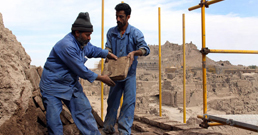The ancient Citadel of Bam in the province of Kerman in southeast Iran has had an illustrious history. It was originally constructed during the Sassanid period and was considerably renovated and extended by the Safavids, after which the whole vast complex covered six square kilometres. Built out of mud brick, the Bam Citadel was the largest structure of its kind in the world. It was a remarkable example of ancient urban construction techniques and one of the most precious remains of pre-Islamic Persian architecture.
The Citadel has also experienced a turbulent history. It has been the scene of fierce clashes and been seized by various tribes and successive dynasties throughout the ages. In the last of such conflicts at the end of the 18th century, the inhabitants of the Citadel were massacred by the founder of the Qajar dynasty who had recently defeated the last of the Zands.
Subsequently, the Citadel of Bam lost its appeal as a place of residence and people abandoned it in favour of living outside its boundaries. It was last used as a military barracks in the 1930s, but the city around it gradually developed, with the magnificent citadel site acting as a major tourist magnet generating considerable revenue for the entire region.
All this came to an abrupt end on 26 December 2003, when in a matter of seconds a powerful earthquake devastated the Citadel along with much of the rest of Bam and its environs. The reconstruction started almost immediately, but six years on, it seems that this immense task will still take much more time and effort before it is completed. In this multimedia report, we visit the site to watch the work in progress.


